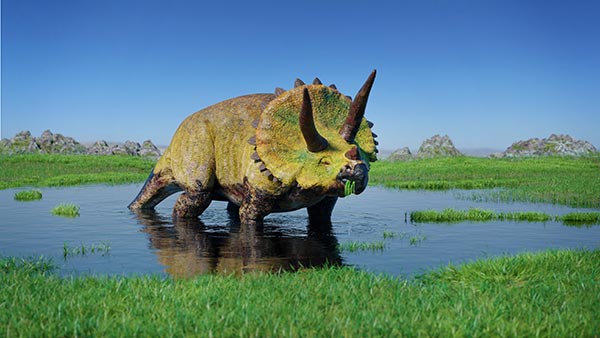
Advertisement
What started out as a simple construction job turned into a mission to find, document and retrieve the remains of a prehistoric giant.
Builders tasked with excavating a site near a retirement community in Denver, Colorado, stumbled upon a partial skeleton, which was later identified by paleontologists as that of a large adult Triceratops.
According to experts from the Denver Museum of Nature and Science, who were brought in to study the recently unearthed fossil, the partial skeleton comprised a limb bone and several ribs of the horned behemoth.
The bones, the experts said, are believed to date as far back as 68 million years ago.
Construction crews are now manning heavy equipment in an attempt to find other dinosaur fossils that may be in the area.
In a statement, the Denver Museum of Nature and Science stated that of all the dinosaur bones discovered in Colorado, the remains of Triceratops have been among the most common.
According to paleontologists, the Triceratops and its relatives in the Ceratopsidae family were confined to the island continent of Laramidia during the Late Cretaceous. Laramidia was an ancient landmass composed of what is now Colorado, as well as most of the west coast of the United States and Canada.
One other landmark in the area, the aptly named Dinosaur Ridge, is also famous for its rich fossil deposits.
“It’s always exciting to get a call about possible fossils, and I can’t wait to share more details as we continue to dig,” Tyler Lyson, curator of vertebrate paleontology at the museum, said in a written statement.
“Finds like this, while relatively rare, are a great reminder of how dynamic our planet is and how much more there is out there to discover,” Lyson added.
Lyson and his team have worked closely with Wind Crest and Brinkmann, the firm behind the original dig, in order to safely explore the site, adding that the museum’s team is currently working to determine the number and type of fossils recovered from the area so far. (Related: A glimpse of the past: Photographer “reanimates” dinosaur skeletons through photographs.)
The Denver Museum of Nature and Science currently has close to 115,000 dinosaur, plant and mammal fossils in its collection.
This is not the first time that a ceratopsid was unearthed in a similar manner. In 2017, a partial skeleton, identified as that of another ceratopsid, the Torosaurus, was discovered at another Denver construction site.
Fast facts on Triceratops
The Triceratops was a genus of herbivorous, horned dinosaurs common during the Late Cretaceous.
One of the most recognizable dinosaurs, the Triceratops is known for its distinct bony neck frill, as well as the impressive crown of horns on its head.
First discovered near Denver, Colorado by George Lyman Cannon in 1887, the Triceratops has two distinct species, differentiated only by the shape and size of their toothless beaks. However, the two species grew to similar sizes, with most experts estimating the animals’ adult sizes to be comparable to that of African elephants.
According to an article published in the journal Cretaceous Research, the Triceratops grew to up to 30 feet in length and weighed well over 11,000 lbs.
Although Triceratops are commonly portrayed in art and popular culture as herding animals, there is currently little evidence that they lived in herds. In line with this, many experts think the animals may have lived solitary lives, only coming together in groups during the mating season.
Sources include:
Advertisement
Advertisements
















